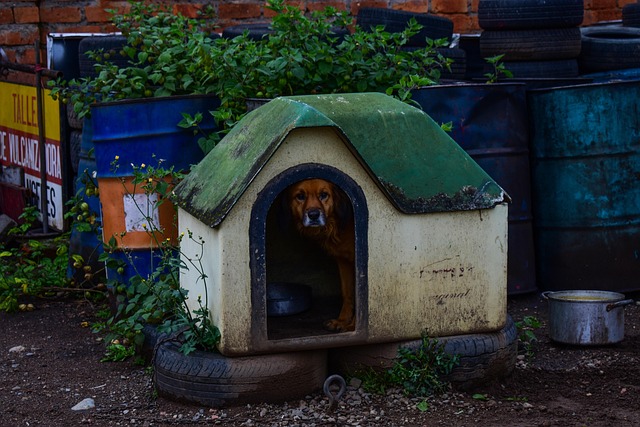Portable warmth solutions, particularly Heated Dog Houses, have gained popularity among pet owners seeking to ensure their furry friends' comfort and safety during colder months. These innovative products offer cozy sanctuaries for pets outdoors, preventing hypothermia and reducing cold-related stress. Heated dog houses feature customizable warmth settings, advanced heating systems, insulation, weatherproof materials, and ventilation for energy efficiency. When choosing a heated dog house, consider climate, size, design, and construction material. Proper care includes regular cleaning, inspection of heating elements, and supervision to ensure safety and longevity. In diverse climate conditions, heated dog houses extend comfort zones, enhancing outdoor lifestyle choices. They provide significant advantages over traditional dog houses in harsh weather, despite higher costs and energy consumption. Future trends include smart, eco-friendly solutions with temperature sensors and renewable energy sources, promising bright prospects for pet welfare.
In today’s diverse climate, providing adequate warmth for our furry friends is more essential than ever. Portable warmth solutions, particularly heated dog houses, offer a convenient and effective way to ensure pets stay cozy year-round. This comprehensive guide explores the benefits of heated dog houses, from understanding their functionality to choosing the right model and maintenance tips. We delve into real-life applications, compare traditional dog houses with heated options, and look ahead to future trends in portable pet heating technologies.
Understanding Portable Warmth and Its Benefits for Pets

Portable warmth solutions, such as heated dog houses, have become increasingly popular among pet owners looking to provide comfort and safety for their furry friends during colder months. These innovative products are designed to offer a cozy sanctuary for pets outside, ensuring they stay warm and comfortable even in frigid weather conditions.
Heated dog houses provide numerous benefits, from preventing hypothermia to reducing stress caused by extreme cold. By maintaining a consistent temperature, these portable heated structures allow pets to relax and play outdoors without the discomfort associated with freezing temperatures. Moreover, many heated dog houses feature customizable settings, allowing owners to control the level of warmth their pets receive, ensuring optimal comfort year-round.
Heated Dog Houses: A Comprehensive Guide

Heated dog houses are a popular solution for pet owners looking to provide year-round comfort and safety for their furry friends. In cold weather, these homes offer insulation and warmth, ensuring dogs remain cozy and healthy outdoors. Heated dog houses come in various sizes and styles, from simple boxes to elaborate structures, each designed to suit different breeds and living conditions. When choosing a heated dog house, consider factors like climate, size of your dog, ease of cleaning, and energy efficiency.
Modern heated dog houses often incorporate advanced heating systems, such as thermostatically controlled heaters, that maintain optimal temperatures. Some even feature digital displays for precise temperature control. Additionally, these houses may have insulation options, weatherproof materials, and ventilation systems to ensure comfort and prevent excessive heat buildup on hot days. With the right heated dog house, you can provide a comfortable living space for your pet, allowing them to enjoy outdoor activities without sacrificing warmth and safety.
How Do Heated Dog Houses Work?

Heated dog houses provide a comfortable and safe haven for your furry friends, especially during colder months. These innovative solutions are designed to mimic the warmth and security of a home, offering a cozy retreat for dogs of all sizes. The core principle behind heated dog houses is simple: they utilize electricity to generate heat, ensuring a consistent temperature that keeps pets warm and content.
The process involves integrating a heating element within the dog house, often with adjustable settings to cater to different climates and individual dog needs. Some models feature remote controls or timers for convenient operation, allowing owners to monitor and control the warmth from afar. This technology not only provides physical comfort but also promotes better sleep patterns in dogs, mimicking the natural ambient temperatures they’d experience outdoors during milder seasons.
Choosing the Right Heated Dog House: Factors to Consider

When selecting a heated dog house, several factors come into play to ensure your furry friend stays cozy and comfortable during colder months. One of the primary considerations is the climate you live in; different regions demand varying levels of insulation and heating capacity. For instance, if you reside in an area with sub-zero temperatures, a more robust, double-insulated heated dog house will be ideal, whereas milder climates might suffice with a standard model.
Size and design are equally important. Ensure the dog house provides enough space for your pet to stand, turn around, and lie down comfortably. Consider the breed and size of your dog; larger breeds may require extra room. Additionally, the material used in construction significantly impacts both insulation and durability. Some heated dog houses offer removable panels or adjustable settings, allowing you to customize the comfort level according to seasonal needs.
Maintenance and Safety Tips for Pet Heating Solutions

When it comes to maintaining a comfortable environment for your furry friends during colder months, a heated dog house can be an excellent solution. However, proper care and safety precautions are essential to ensure its longevity and your pet’s well-being. Regular cleaning is key; remove any debris or accumulation inside the heated pad or bed to prevent bacterial growth. Check the heating element for signs of wear and replace it if necessary to avoid electrical hazards. Always keep an eye on your pet when they’re in their heated shelter, especially if it’s new to them, as sudden temperature changes can be jarring. Ensure proper ventilation to maintain optimal warmth without causing overheating, which could lead to health issues.
Safety first! Never leave a heating device unattended, and make sure it’s plugged into a grounded outlet. Keep the heated dog house away from moisture and direct sunlight to prevent damage and maintain its efficiency. Regularly inspect connections for any loose or damaged wires, addressing these issues promptly to avoid fire hazards. Remember, while a heated dog house offers comfort, supervision is crucial, especially with curious pets that might try to disassemble the shelter. By following these maintenance tips, you can ensure your pet stays cozy and safe during outdoor adventures in all seasons.
Real-Life Applications: Why You Might Need a Portable Warmth Solution

In today’s diverse climate conditions, the need for portable warmth solutions has become increasingly prevalent. Whether you’re an outdoor enthusiast, a pet owner, or simply face frequent cold snaps, finding ways to stay cozy on the go is essential. One innovative application of portable warmth is the heated dog house. This isn’t just about keeping pets comfortable; it showcases the versatility and importance of mobile heating systems. Imagine extending your comfort zone from your home to outdoor spaces, ensuring that your furry friends or even yourself remain warm during extended stays in cold environments.
From camping trips where overnight lows dip dramatically to harsh winter days spent exploring wilderness trails, having a portable warmth solution can make these experiences more enjoyable and safer. Heated dog houses offer a prime example of this technology’s real-life utility, demonstrating how design and innovation can meet practical needs. This is particularly crucial in regions with extreme weather patterns, where access to heating alternatives can significantly enhance outdoor lifestyle choices.
Comparison: Traditional Dog Houses vs Heated Options

In the quest for providing optimal comfort and safety for our furry friends, a direct comparison between traditional dog houses and their heated counterparts is essential. Traditional dog houses, often characterized by their open-air design and natural insulation, offer minimal protection against harsh weather conditions. They rely on the environment to regulate temperature, which can be both a pro and a con—pro when it’s mild outside but a significant drawback during colder months.
Heated dog houses, as the name suggests, incorporate technology to maintain a consistent, comfortable temperature inside. These modern options typically feature heating elements or heated pads, ensuring your pet stays warm even in icy conditions. While they may have higher upfront costs and energy consumption, heated dog houses provide unparalleled relief for dogs living in colder climates. This advancement in pet housing underscores the growing commitment of pet owners to enhancing their companions’ quality of life, especially when outdoor temperatures dip below freezing.
Future Trends in Portable Pet Heating Technologies

As technology advances, so too does our focus on enhancing pet welfare, leading to exciting future trends in portable pet heating technologies. One notable development is the emergence of innovative heated dog houses designed to mimic natural environments while providing consistent warmth. These smart solutions incorporate temperature sensors and adjustable heat settings, ensuring pets stay comfortable year-round, whether they’re enjoying outdoor adventures or relaxing indoors.
Additionally, researchers are exploring eco-friendly options, such as heated beds and pads powered by renewable energy sources. These products not only offer portability but also contribute to a more sustainable approach to pet care. With an increasing demand for technology that prioritizes animal welfare, the future looks bright for portable warmth solutions that provide comfort, safety, and convenience for our beloved pets.
